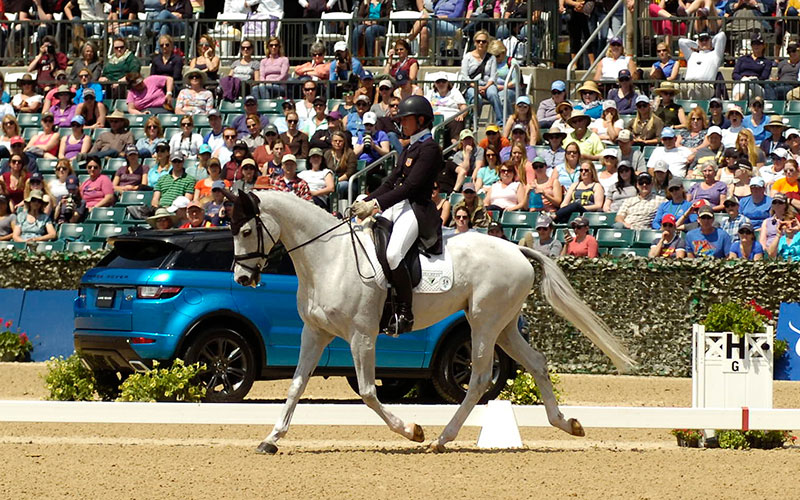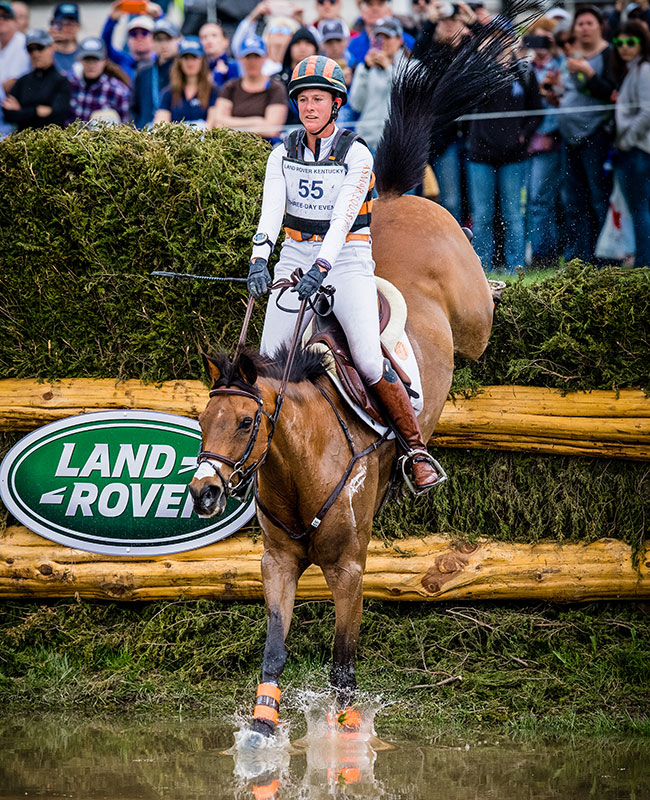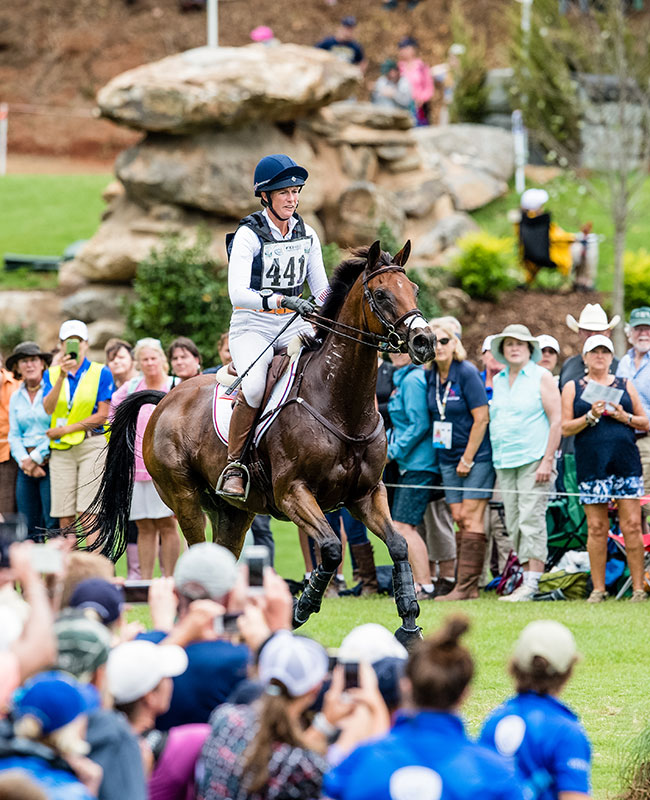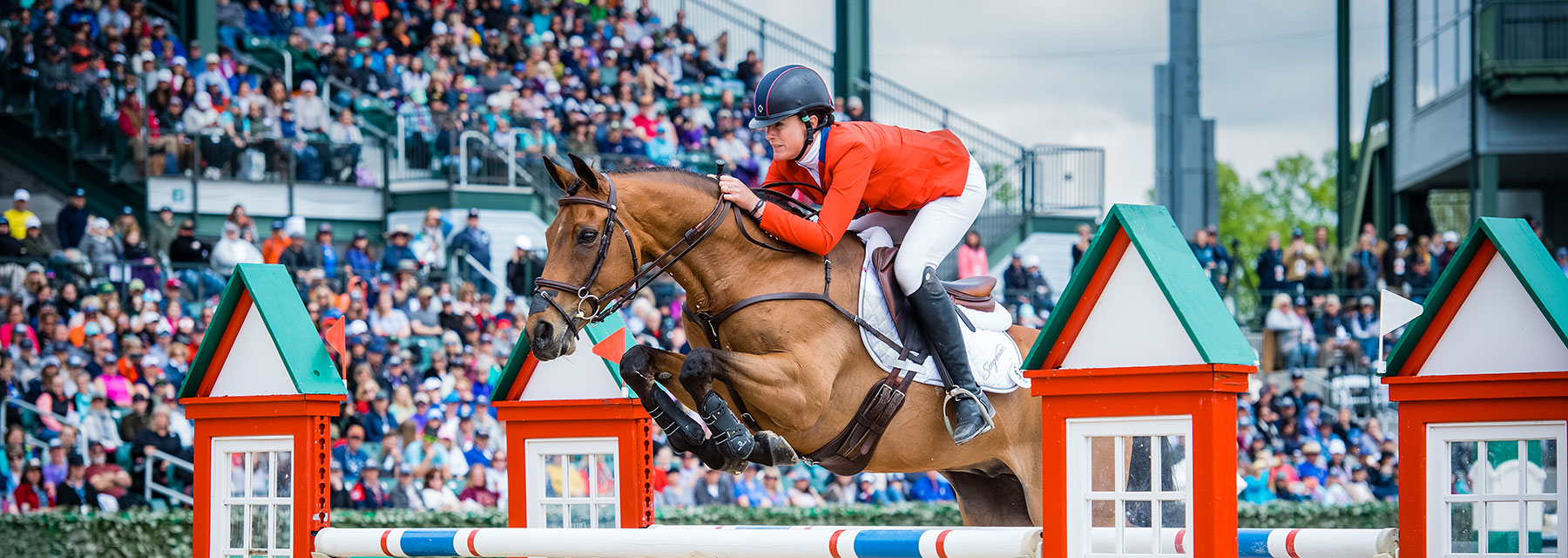The Making of a 3-Day Eventing Championship Horse & Rider
Despite all of her accomplishments to date, it’s possible that Lauren Nicholson, née Kieffer, may just be getting started. The 2019 USEA Lady Rider of the Year hails from a self-proclaimed “non-horsey” family. However, she quickly found a turnkey home in the adrenaline-fueled sport of three-day eventing. Within the horse world, eventing is thought of as an extreme sport — an equestrian triathlon that combines dressage, cross-country and show jumping. Horses must have the discipline to complete the movements of a USDF Third Level dressage test, the fitness to gallop several miles with dozens of natural obstacles for cross-country and the stamina to jump a 1.30 meter course — all with a single night’s rest separating each phase. What may make some exhausted just thinking about it, Nicholson simply could not get enough from the get-go. She displayed a keen talent as a youth, and at just 17-years-old, went to work and train with eventing’s luminaries, David and Karen O’Connor. The O’Connors added jet fuel to her career by honing her raw talent, providing plenty of quality horses to learn the upper-level nuances and introducing her to one of the sport’s major benefactors, Jacqueline Mars. Thriving on hard work, quirky horses and a bit of a wild ride, Nicholson is primed and eager to attack an extended Olympic year with a dreamy string of some of the country’s best sport horses.

PHOTO BY MICHELLE DUNN PHOTOGRAPHY
From the Ground Up
Nicholson grew up in Mt. Carmel, Illinois, as something of an anomaly to her accountant mother and diesel mechanic father. She explains, “My family didn’t have horses around when I was little, but I always loved them. It was never an issue trying to decide whether to ride or not ride as a profession. I don’t think I ever considered doing anything different.” Nicholson continues, “My parents were very supportive, but they weren’t going to bankroll everything. If I was going to ride horses, if I was going to do this as a career, I was going to work for it. So, from the beginning, I had to muck stalls to pay for my lessons. I had to braid. I spent summers and every weekend working at my trainer’s barn and riding every horse I could get.” Her first crack at upper-level eventing was brought about by some good fortune closely followed by countless hours in the saddle and lots of elbow grease. When Lauren was just 14, her family purchased Snooze Alarm from her trainer who was pregnant at the time and sidelined from riding. “Maggot” was a spicy chestnut Anglo-Arabian standing 15.2 hands tall. Interestingly, where most English disciplines have shifted to a nearly complete lineup of warmblood breeds, eventing still holds not only a place but a seemingly-sacred respect and devotion to Thoroughbreds and other hot-blooded breeds. Many eventers rely on the energy and stamina from the “bloodier” breeds to contest the grueling three days of the sport. Although certainly hot-blooded, Arabians are not commonly seen tackling the upper eventing ranks. In 2010, Nicholson rode the unlikely star to complete the then CCI4* Rolex Kentucky Three-Day Event (RK3DE) — the U.S. competition offering the highest level of difficulty — finishing 29th overall.
It could be said that Nicholson has taken a horse from rags to riches — twice. After Maggot’s retirement from elite eventing following the RK3DE, Nicholson did not have the money to invest in another ready-made four-star eventer and took a leap of faith by purchasing Maggot’s full brother, Vermiculus, an unproven two-year-old colt. While very stately sounding, Vermiculus translated from Latin means “little worm or grub,” so-called as a nod of brotherly love to Maggot. Nicholson has guided the brave, talented and very cheeky “Bug” at his own pace up the ranks from an unruly novice through five-star competition and has made him into the professional that he is today. Because of her equine “insect collection,” Nicholson is very familiar with taking one’s time and the tireless patience that goes into bringing along a Championship horse — and knows firsthand that they do not necessarily display star power from the onset. Vermiculus was not only a semi-feral young horse, but he was not particularly competitive as a three- or even a four-star horse; no one really knew him. Nicholson remembers, “Once he was given a five-star chance, then he was considered a proper competitor and had a chance to prove himself.” In essence, the 4-mile tracks, 6-foot spreads and drops and solid obstacles finally got his attention. “A lot of my five-star horses, as young horses, I wouldn’t have picked them to be five-star horses,” she says, laughing. “The longer I do this sport, the more I find that I can get to the three- or four-star level with a good athlete. The difference with the five-star horses is their brain. Up to the 4-star level is almost an entirely different animal from a five-star one.”
“The longer I do this sport, the more I find that I can get to the three- or four-star level with a good athlete. The difference with the five-star horses is their brain.”
— Lauren Nicholson, 2019 USEA Lady Rider of the Year

Lauren Nicholson was the 2019 FEI World Ranking Top American.
PHOTOS BY SHANNON BRINKMAN

When completing the cross-country course, Lauren Nicholson is flanked by spectators.
PHOTO BY SHANNON BRINKMAN
The Making of a 5-Star Horse
While Snooze Alarm may have turned heads at Nicholson’s first Kentucky 3-Day Event, Veronica is the horse that sealed her status in the eventing Big Leagues and was her mount in the 2016 Olympic Games in Rio de Janeiro, Brazil. “She made my name in the sport and took me all over the world. I owe her and her owners, Team Rebecca, so much,” Nicholson says fondly. Aside from Veronica, who was a wonderfully made horse when Nicholson got the ride from Karen O’Connor, Lauren has devoted much of her time and energy over the years doing what she loves: bringing young horses along and up the levels from the very beginning and through wherever they end up athletically. “I definitely have a real close connection to those horses that we’ve had since they were young horses or the ‘homebreds,’ like Landmark’s Monte Carlo, that I’ve had since they were foals all the way up. And Vermiculus, I’ve had since he was two. I get very emotionally attached to all of them. I know them inside and out, and they know me inside and out.” Nicholson relies on a deep partnership with her horses and has to know that when it comes down to it, they’re going to fight and be able to get themselves out of trouble. “I have to know the horses really well. I like to know their personalities and have them know me because in this sport, especially in the cross-country, you really need to have a partnership.”
The young horses that Nicholson trains all receive the same basics. “We try to keep it as natural as possible in their training. And then it’s up to the individual. I absolutely train each horse as an individual.” She continues, “Some horses have a natural ability for dressage, and so we’ll end up doing a bit more of the jumping and cross-country in the beginning or vice versa. Some horses that are naturals out in the (jumping) field will need to do more dressage. It really depends on the horse. We try to find a good balance for them and progress them as slow as they need. Some horses really click to it quickly, and some others get stuck in a bit of a gangly teenager stage for a while and take a long time to get their balance and coordination. And that’s okay. We go at their speed.” The basic routine includes trot days and canter days and certain days specifically set aside for dressage or jumping. They will spend hours walking and trotting on imperfect ground to flex their legs differently and toughen them up just as they would need to do on the cross-country course. Nicholson and her team create a plan several months in advance for each horse and what the goals are for each individual. Fitness is one of the most significant portions of the training process. “I really hate riding a tired horse,” remarks Nicholson. Everything is done at a steady progression to build stamina while avoiding soreness and body issues. The horses will slowly build up trotting and cantering times and increase distances.
There are a lot of equine athletes out there. So, how does a horse become a top eventer? Of course, it takes a lot of training and definitely natural talent. But then it takes a bit more — something special, something innate. “Five-star horses and five-star riders are both physically competitive, and they love to be challenged mentally. They love to be able to attack this sport and head out into battle,” Nicholson explains. This is something that can be nurtured but not really taught. And they are qualities that do not necessarily surface until they are pushed to the limits for the first time and faced with an insurmountable task. “Now in the sport, they need to be such good jumpers and movers to be competitive at the top level. But equally as important, they have to be very, very careful,” Nicholson adds. To ensure that these horses remain confident, Nicholson explains, “With these very careful young horses, I’ve found it to be beneficial to step them up and then step down the next weekend, and kind of go back and forth a bit because the really careful ones can get scared if every weekend is more difficult than the last. They can get a little worried, so I always find it important to make some weekends easy. It helps them feel secure and keeps their confidence up.” Patience seems to organically make room for relationship building, which is such a critical part of Championship horse and rider combinations. “Honestly, the slower you go, the faster you get there,” she says. “Listening to each horse and going at their individual speed is the fastest and most direct way to train them. Once it feels like the level they’re doing is simple and boring, and you don’t have much homework or something you need to fix every time, and they have correct footwork, then it’s time to consider moving them up.” Nicholson’s number one rule: produce each horse on an individual timeline based on his own confidence.
Beyond physical training elements, Nicholson relies heavily on a nutrition program that combines simplicity with a tailoring to the individual horse. It centers around a natural, forage-based diet with all of her horses spending the majority of the day turned out. “My philosophy, which I took from growing up in the O’Connor’s program, is that horses should be horses,” says Nicholson. “Our horses come in at 7 o’clock in the morning. They get fed. They get groomed and ridden. Then, they go back to turnout as soon as possible, no later than 2 o’clock in the afternoon, and spend the rest of the day and night outside on grass.” Nicholson chalks up general well-being, and happy, healthy horses to this cornerstone of her program. “It’s just what they’re supposed to do. They’re designed to walk around and graze all day.” She continues, “We really don’t have issues with keeping weight on them. We don’t really deal with ulcers, and I know it really helps their joints. When they’re out there grazing, it just keeps them physically and mentally healthy.”
The rest of the diet depends on what each horse requires and what is the best fuel to keep up with energy demands without making the horse hot. Older horses or younger horses may need special adjustments. Some horses may need support with muscle recovery, circulation, joints and other specific needs. “Nutrition is something we spend a lot of time talking about, researching and discussing with the experts at Buckeye and Platinum and with our vets and physios — what we think each horse needs to help them be at their best. We’re constantly adjusting it to their needs. We don’t put every horse on the same thing. Each horse has a very detailed nutrition and supplement program that they’re on. Nutrition is really important to our program and to these horses as athletes.” Some of Nicholson’s favorites are Platinum Performance® CJ, Vitamin E, Platinum Gastric Support®, Platinum Electrolyte, Platinum Skin & Allergy and Healthy Weight.
A Closer Look: What is a CCI*****?
With only six hosted annually around the world, these events are the most prestigious and difficult tests of horse and rider offered in the sport with sophisticated tests of physical stamina but also mental tiredness and confidence as well.
- Dressage is a test in itself as it asks extremely fit horses ready to bear down on four miles of cross-country at a clip to first demonstrate attention, grace and focus through a rigorous and calculated dance sequence.
- The cross-country course typically contains between 40 to 45 jumping efforts over several miles of terrain, taken on at a gallop with speeds of more than 21 miles per hour. Five-star cross-country tracks are technical and demanding, particularly as they will boast maxed-out dimensions of 3’11” fence heights, over 6’ spreads and allow 6’6” drops.
- Show-jumping courses are set to about 4’3” and ask for more precision and yet another display of fitness following just an overnight rest to recover from the physically and mentally demanding cross-country phase.
Views from the Top
All equestrian sports have some amount of inherent risk, and three-day eventing is no exception. But competitive riders are drawn to the challenge, and eventers especially to its multi-discipline aptitude requirement. “I think eventers are perfectionists. Especially in this day and age, there’s something very appealing about being able to master three different sports in one. I think a big draw for top-level eventers is that you can’t be a jack of all trades anymore. You have to be a master of all trades.” When all the hard work pays off, the top is reached, and the event ends on the dressage score, there is not a feeling like it in the world.
As they said in the 1919 jingle, Nicholson has “seen Paree” — or more contextually Toronto, Rio, Pau, Burghley and Badminton. For her young age, she is a veteran and has been there, done that and competed successfully at many venues on many horses. Lauren Nicholson was the 2019 FEI World Ranking Top American. She also fell off on cross-country at the 2018 World Equestrian Games. She won a gold medal with Team USA at the 2015 Pan American Games in Toronto. She was also eliminated after a fall at the 2016 Rio Olympics. She has twice received the Pinnacle Cup Trophy awarded to the leading American rider at the Kentucky Three Day Event. She has also retired two of her best horses due to hoof issues. “You know, we have to keep a certain level of levity with it all because we have such high highs and low lows,” she says, smiling. “Unlike other disciplines that have the option to do a five-star every other weekend, eventers get two chances a year to do one, if we’re having a great year. You just have to let the lows go and not let the highs get too high because eventing is a constant roller coaster, and that’s what makes it such an awesome and incredibly challenging sport.” The highs are ecstasy and the lows are heartbreaking — but that’s the sport. Eventers have to learn from failures, then let them go, move on and refocus, and sometimes they have less than 24 hours to get that accomplished. Crazy? Maybe. Tough? Definitely. But a defining factor in what makes a Championship horse is the same thing in a Championship rider: a lion’s heart. No one said it was easy — and Lauren Nicholson would not be doing it if it was.

by Emily Smith, MS,
Platinum Performance®
